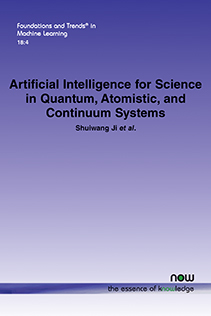Artificial Intelligence for Science in Quantum, Atomistic, and Continuum Systems
By Xuan Zhang, Texas A&M, | Limei Wang, Texas A&M, | Jacob Helwig, Texas A&M | Youzhi Luo, Texas A&M | Cong Fu, Texas A&M University | Yaochen Xie, Texas A&M University | Meng Liu, Texas A&M University | Yuchao Lin, Texas A&M | Zhao Xu, Texas A&M | Keqiang Yan, Texas A&M | Keir Adams, MIT | Maurice Weiler, AMLab | Xiner Li, Texas A&M | Tianfan Fu, Univ. of Illinois Urbana-Champaign | Yucheng Wang, Texas A&M | Alex Strasser, Texas A&M | Haiyang Yu, Texas A&M | YuQing Xie, MIT | Xiang Fu, MIT | Shenglong Xu, Texas A&M | Yi Liu, Stony Brook | Yuanqi Du, Cornell | Alexandra Saxton, Texas A&M | Hongyi Ling, Texas A&M | Hannah Lawrence, MIT | Hannes Stärk, MIT | Shurui Gui, Texas A&M | Carl Edwards, Univ. of Illinois Urbana-Champaign | Nicholas Gao, Technical University of Munich | Adriana Ladera, MIT | Tailin Wu, Stanford | Elyssa F. Hofgard, MIT | Aria Mansouri Tehrani, MIT | Rui Wang, Univ. of California San Diego | Ameya Daigavane, MIT | Montgomery Bohde, Texas A&M | Jerry Kurtin, Texas A&M | Qian Huang, Stanford | Tuong Phung, MIT | Minkai Xu, Stanford | Chaitanya K. Joshi, Univ. of Cambridge | Simon V. Mathis, Univ. of Cambridge | Kamyar Azizzadenesheli, Nvidia | Ada Fang, Harvard | Alán Aspuru-Guzik, Univ. of Toronto | Erik Bekkers, AMLab | Michael Bronstein, Univ. of Oxford and AITHYRA | Marinka Zitnik, Harvard | Anima Anandkumar, Nvidia and Caltech | Stefano Ermon, Stanford | Pietro Liò, Univ. of Cambridge | Rose Yu, Univ. of California San Diego | Stephan Günnemann, Technical University of Munich | Jure Leskovec, Stanford | Heng Ji, Univ. of Illinois Urbana-Champaign | Jimeng Sun, Univ. of Illinois Urbana-Champaign | Regina Barzilay, MIT | Tommi Jaakkola, MIT | Connor W. Coley, MIT | Xiaoning Qian, Texas A&M and Brookhaven National Laboratory | Xiaofeng Qian, Texas A&M | Tess Smidt, MIT | Shuiwang Ji, Texas A&M, sji@tamu.edu
Abstract
Advances in artificial intelligence (AI) are fueling a new paradigm of discoveries in natural sciences. Today, AI has started to advance natural sciences by improving, accelerating, and enabling our understanding of natural phenomena at a wide range of spatial and temporal scales, giving rise to a new area of research known as AI for science (AI4Science). Being an emerging research paradigm, AI4Science is unique in that it is an enormous and highly interdisciplinary area. Thus, a unified and technical treatment of this field is needed, yet challenging. This work aims to provide a technically thorough account of a subarea of AI4Science; namely, AI for quantum, atomistic, and continuum systems. These areas aim at understanding the physical world from the subatomic (wavefunctions and electron density), atomic (molecules, proteins, materials, and interactions), to macro (fluids, climate, and subsurface) scales and form an important subarea of AI4Science. A unique advantage of focusing on these areas is that they largely share a common set of challenges, thereby allowing a unified and foundational treatment. A key common challenge is how to capture physics first principles, especially symmetries, in natural systems by deep learning methods. We provide an in-depth yet intuitive account of techniques to achieve equivariance to symmetry transformations. We also discuss other common technical challenges, including explainability, out-of-distribution generalization, knowledge transfer with foundation and large language models, and uncertainty quantification. To facilitate learning and education, we provide categorized lists of resources that we found to be useful. We strive to be thorough and unified and hope this initial effort may trigger more community interests and efforts to further advance AI4Science.
Artificial Intelligence for Science in Quantum, Atomistic, and Continuum Systems
Decades of artificial intelligence (AI) research have culminated in the renaissance of neural networks under the name of deep learning. Intensive research has led to many breakthroughs in this area, including, for example, ResNet, diffusion and score-based models, attention, transformers, and recently large language models (LLM) and ChatGPT. These developments have led to continuously improved performance for deep models. When coupled with growing computing power and large-scale datasets, deep learning methods are becoming dominant approaches in various fields, such as computer vision and natural language processing. Propelled by these advances, AI has started to advance natural sciences by improving, accelerating, and enabling our understanding of natural phenomena at a wide range of spatial and temporal scales, and giving rise to a new area of research known as AI for science (AI4Science). Being an emerging research paradigm, AI4Science is unique in that it is an enormous and highly interdisciplinary area. Thus, a unified and technical treatment of this field is needed, yet challenging.
This monograph provides a technically thorough account of a subarea of AI4Science; namely, AI for quantum, atomistic, and continuum systems. These areas aim to understand the physical world from the subatomic (wave functions and electron density), atomic (molecules, proteins, materials, and interactions), to macro (fluids, climate, and subsurface) scales and form an important subarea of AI4Science. A unique advantage of focusing on these areas is that they largely share a common set of challenges, thereby allowing a unified and foundational treatment. A key common challenge is how to capture physics first principles, especially symmetries, in natural systems by deep learning methods. An in-depth yet intuitive account of techniques to achieve equivariance to symmetry transformations is provided. Other common technical challenges, including explainability, out-of-distribution generalization, knowledge transfer with foundation and large language models, and uncertainty quantification, are also discussed. To facilitate learning and education, categorized lists of resources that we found to be useful are provided. The presentation is thorough and unified and it is hoped that this initial effort may trigger more community interests and efforts to further advance AI4Science.
